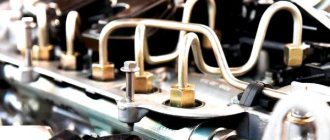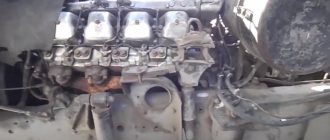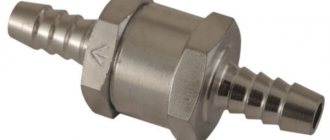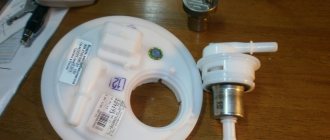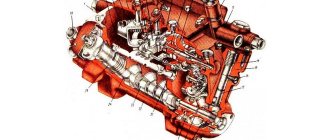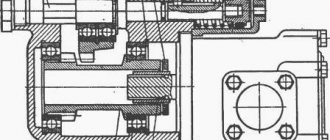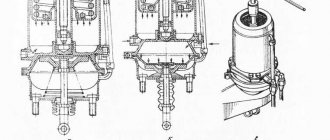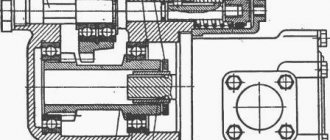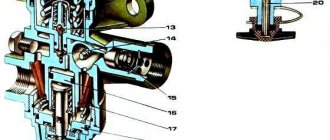The power supply system (fuel system) of an engine with a Solex carburetor, front-wheel drive VAZ 2108, 2109, 21099, has two lines: a fuel supply from the gas tank to the carburetor and a return line from the carburetor to the gas tank (“return”). The return line is designed to drain excess fuel from the carburetor when the car engine is running in different modes.
Solex carburetor fuel return system design
— Fuel return fitting with calibrated hole
Designed to limit the volume of fuel drained into the return line. This ensures optimal pressure in the fuel line from the fuel pump to the carburetor needle valve.
— Fuel return line
Rubber hoses and a metal tube under the bottom of the car from the fuel return fitting of the carburetor to the fitting on the fuel pick-up in the fuel tank, through which excess fuel is drained into the fuel tank.
— Check valve
Only allows fuel to flow in one direction. Designed to prevent fuel from spilling out of the gas tank when the vehicle rolls over.
Operating principle of the Solex carburetor fuel return system
When the engine is running, the fuel pump creates a certain pressure in the fuel supply line up to the needle valve. This pressure is excessive for normal operation of the carburetor needle valve (possible “overflow”). Therefore, excess fuel is discharged through a fuel outlet fitting with a calibrated hole into the return line and then into the gas tank. This ensures normal operation of the carburetor and car engine, cooling of the fuel pump and the fuel passing through it due to its constant circulation, and removal of air pockets from the fuel pump and fuel supply line. A calibrated hole in the fuel return fitting, which meteres the volume of drained fuel, ensures that the required pressure is maintained in front of the carburetor needle valve.
Fuel return system malfunctions
The main malfunctions are clogging of the return line and failure of the check valve. As a result, the drain line stops functioning normally, the fuel pressure on the needle valve increases, it begins to pass it into the float chamber, the level in it rises, causing excess fuel to enter the engine through the carburetor GDS system. The fuel mixture becomes very rich. As a result, spark plugs flood and interruptions in engine operation in different modes. Among other things, the fuel pump overheats greatly, and air pockets form in it and the supply line. The engine stalls. In some cases, a wet rag placed on top of the fuel pump helps to quickly restore the functionality of the fuel pump.
Therefore, the permeability of the return line and the check valve of the fuel system must be periodically checked (blowed in the direction of the gas tank, with the cap removed from its filler neck); if clogged, it must be cleaned.
— In addition to the above, the fuel return system to the gas tank prevents a sharp increase in fuel pressure on the carburetor needle valve after stopping the car engine.
— An increase in fuel pressure at the carburetor inlet can also occur due to a malfunction of the fuel pump valves or incorrect adjustment of its drive.
More articles on the fuel system of carburetor engines
— Ventilation system for the gas tank of carburetor engines of VAZ 2108, 2109, 21099 cars
What is a fuel injection pump bypass valve
The injection pump bypass valve (reducing valve) is a high-pressure fuel pump assembly of diesel engine power supply systems, an adjustable valve (hydraulic throttle) for draining excess fuel and maintaining the required fuel pressure in the pump.
The bypass valve performs several functions:
- Draining excess fuel from the pump;
- Removing air trapped in the fuel system;
- Maintaining constant fuel pressure inside the pump (in the channels of the pump sections of multi-section high-pressure fuel pumps and in the housing of the distribution high-pressure fuel pumps).
Air preparation system for pneumatic system
Compressor 1 supplies compressed air through pressure regulator 2 to air dryer 3 . The purpose of the automatic regulator is to maintain air pressure in the pneumatic system within specified limits, for example (7.2 - 8.1 bar). The dehumidifier removes the moisture contained in the air, which is removed from the system through the ventilation duct. The prepared air is supplied to a 4-circuit protective pneumatic valve 4 , which prevents a decrease in the operating pressure in the brake system in the event of a failure in one or more circuits of the brake system. Receivers (6 and 7) ensure operation of the circuits of the first and second brake systems through the brake valve 15 . Air enters circuit 3 from receiver 5 through automatic connecting head 11 , trailer brake control valve 17 , 2-position valve (2-way), check valve 13 , parking brake system valve 16 and accelerator valve 20 into the spring energy accumulator chamber pneumatic cylinder 19 . Circuit 4 is designed to supply power to auxiliary consumers of compressed air, for example, a motor brake. Air is supplied to the trailing brake system through the connecting head 11 and the hose to the receiver. Then, through the main air filter 25 and the trailer brake valve 27 , it enters the receiver 28 and then to the ABS accelerator valves 38 .
Types, design and principle of operation of the injection pump bypass valve
First of all, it should be noted that today there are several types of valves that provide fuel bypass to the injection pump:
- Bypass (reducing) valve in multi-section pumps;
- Bypass (reducing) valve for regulating pressure inside the housing (at the inlet to the pump section of the fuel priming pump) in a distribution-type injection pump;
- Bypass throttling valve in distribution type pumps.
Each of the valves has its own design features and occupies a specific place in the high-pressure fuel pump.
Bypass valve in multi-section fuel injection pumps. This valve is installed in the front wall of the pump housing; it is connected to the fuel supply channels from the fuel priming pump to the discharge sections. Structurally, the valve is very simple: its basis is a body, inside of which there is a spring-loaded shut-off element in the form of a ball or disk. The housing can be of two types:
- Bolt. The valve is made in the form of a bolt, inside of which there is a shut-off element, and two or more holes are made on the walls to drain fuel into the return line. The bolt is screwed into the pump body; it holds the connecting nipple, to which the return line is connected;
- Union. The valve is made in the form of a fitting, inside of which there is a shut-off element. The fitting is screwed into the pump housing, and the return line is connected to the external thread.
This type of bypass valve works as follows. At low pressure in the supply line, the valve is closed due to spring force - fuel is supplied to the discharge sections. When the engine operating mode changes, the operation of the injection pump and the fuel priming pump also changes; at some point, the fuel pressure in the supply line increases, which can complicate the operation of the injection sections. When the threshold pressure is exceeded (which lies at the level of 58-80 kPa), the spring force is overcome and the valve opens - excess fuel is discharged into the tank through the return line. When the pressure drops, the valve closes again.
It should be noted that in multi-section pumps, the pressure reducing valve is mainly responsible for removing excess fuel, and air is removed from the system by a nozzle valve installed on the fine fuel filter.
Bypass valve of distribution injection pumps. This valve performs the same functions as the bypass valve of multi-section pumps. It is installed immediately after the fuel priming pump and discharges excess fuel when the pressure rises. The valve can be made in the form of a bolt or fitting, or it can be built directly into the pump housing.
Throttling valve for bypass of distribution injection pumps. This unit combines two parts - a fuel drain nozzle and the bypass valve itself. Distribution-type pumps have a drain jet - a small-diameter hole through which fuel is constantly drained into the return line. The jet circulates fuel through the pump, due to which the parts of the unit are cooled and air is removed from it. In some pumps, there is no nozzle as such; it is combined with a bypass throttling valve, which at low pressure always allows a certain amount of fuel to pass through, and when the pressure rises, it opens and dumps excess fuel into the return line.
The bypass throttling valve has a design similar to a conventional bypass valve, but its body has an additional small-diameter hole - a nozzle, permanently connected to the return line. The valve shut-off element is located above the jet and does not close it. As pressure increases, the shut-off element overcomes the elasticity of the spring, rises and opens the main drain hole - in this case, excess fuel enters the return line. When the pressure drops, the shut-off element returns to its original position and fuel is drained only through the nozzle.
How can you check a check valve?
You can find out what condition the fuel valve is in as follows.
Using a pressure gauge, check the pressure. It should be within 3 kg per cm2. These are figures for passenger cars.
You can find out how the device works by pinching the “return” fuel hoses. If the permanent mechanical structure is in order, the pressure should increase.
For your information.
This method is only for cars that have rubber hoses installed.
Self-diagnosis can be carried out without using a pressure gauge. This concerns the problem of unstable operation of the internal combustion engine (ICE) and poor acceleration. Having pinched the rubber hose that moves the fuel in the opposite direction, you need to pay attention to the operation of the engine. If the speed increases and the engine cylinders operate as planned, then the check valve is faulty.
Correct selection and replacement of the injection pump bypass valve
Reducing valves have an extremely simple design, but they are constantly subjected to high loads and quite often fail. Valve malfunction is manifested by deterioration of engine performance - it loses throttle response and in some modes there is a noticeable deterioration in its performance. In these cases, it is necessary to dismantle and check the valve, and, if it is faulty, replace it.
To replace, it is necessary to select a bypass valve of the same type and model that is installed on the injection pump by the manufacturer - only in this case there is a guarantee that the valve has the necessary characteristics and will ensure normal operation of the pump. Many valves allow adjustment of the pressure at which fuel is bypassed - this adjustment must be made in strict accordance with the instructions for maintenance and repair of the car/tractor. As a rule, adjustment comes down to changing the number of washers placed under the valve head, although there are exceptions - it all depends on the specific type of device.
With the correct selection, replacement and adjustment of the pressure reducing valve, the fuel pump will operate effectively in all modes, ensuring normal operating characteristics of the power unit.
The fuel line and the injector ramp that supplies the engine injectors operate under a pressure of about 3 bar. Since gasoline is supplied by an electric pump, the system uses a special valve that limits the fuel pressure. Otherwise, the nozzles will leak and the engine will choke on the over-enriched mixture. To avoid problems with fuel supply, you need to promptly diagnose the signs of a malfunction of the fuel pressure regulator (abbreviated as RTD) and know how to eliminate it.
Which way to go
There are two options for eliminating the problem. Take the car to a service station and wait for the repairs to be completed. In this case, you need to shell out a certain amount of money, it’s a pity.
Having knowledge and understanding of the car’s structure, you can carry out repairs yourself. Saving money in person. However, there is a possibility of stepping on a pitfall. Can't deal with the problem.
Then you will have to shell out additional money for repairs in a specialized center, how do you like this prospect? In any case, the decision is yours to make.
Experts recommend not to reinvent the wheel, but to give the car to professionals who will replace it quickly, with a guarantee of quality.
Vote, did you like the article?
Why is a control valve needed?
The fuel supply system of most passenger cars requires continuous operation of an electric fuel pump. It constantly pumps gasoline into the fuel line and ramp, raising the pressure to the maximum (5–7 Bar depending on the brand of car). But such performance is needed only under increased load on the engine, when it develops high speeds and consumes a lot of fuel mixture. In normal mode, a fuel pressure at the injectors of 3–3.5 bar is sufficient.
The fuel pressure diaphragm valve, installed in the engine power system after the fuel pump, performs 3 main functions:
- Limits the fuel pressure in the line at low engine loads, dumping excess fuel back into the tank through a separate tube.
- When the gasoline consumption of the power unit increases, the return flow is partially or completely blocked by the regulator. In this way, the valve maintains the minimum pressure required for normal operation of the motor.
- Maintaining pressure for a long time after stopping the power unit.
Without an RTD, the pump would “push through” the locking mechanisms of the injectors and gasoline would flow into the cylinders uncontrollably. In addition, the regulator protects the line from leaks at the connections, which will inevitably appear under the influence of strong pressure.
Fuel return line (“return”)
Fuel systems
As a rule, it has constant performance, that is, it pumps fuel from the tank into the ramp under constant pressure. The engine operates in different modes, consuming different amounts of fuel, depending on its load. Thus, it becomes necessary to control the pressure and amount of fuel in the fuel rail.
This is done by draining excess fuel back into the tank through the fuel return line, the so-called “return”. Currently, there are two types of fuel systems, differing in the presence or absence of a fuel return line (return line).
- Fuel supply system with return line. Fuel that is not injected by the injector is excess fuel and it returns back to the tank through the regulator, which is located on the fuel rail, and the return line. In this way, constant pressure is maintained in the fuel manifold.
- Fuel system without return line. The fuel pressure regulator in such systems is usually installed in the submersible fuel pump module. Excess fuel supplied by the pump is returned back to the tank through a short return line. In this case, only the amount of fuel that is injected by the injectors is supplied to the fuel rail. This system has the following advantages: lower cost and less heating of the fuel in the tank.
Operating principle of RTD
The valve design and operating principle depend on the type of fuel system of a particular vehicle. There are 3 ways to supply gasoline from the tank to the injectors:
- The pump together with the regulator is installed inside the tank; fuel is supplied to the engine through one line.
- Gasoline is supplied through one tube and returned through another. The fuel system check valve is located on the distribution rail.
- The circuit without a mechanical regulator provides for electronic control of the fuel pump directly. The system contains a special sensor that registers pressure; the pump performance is regulated by the controller.
In the first case, the return flow is very short, since the valve and electric pump are interlocked into a single unit. The RTD, located immediately after the supercharger, dumps excess gasoline into the tank, and the required pressure is maintained throughout the supply line.
Reference. The first scheme with a regulator inside the gas tank has been implemented on all Russian-made VAZ cars.
The second option is used in most foreign cars. A valve built into the fuel rail allows excess fuel to flow into the return line leading to the tank. That is, 2 gasoline pipes are laid to the power unit.
There is no point in considering the third circuit - instead of a regulator, there is a sensor whose functionality is checked using a computer connected to the diagnostic connector.
A simple fuel pressure valve installed in the fuel pump unit consists of the following elements:
- cylindrical body with pipes for connecting the supply and return lines;
- a membrane connected to a locking rod;
- valve seat;
- spring.
Price
Below are the prices and part numbers for the fuel pump, depending on the manufacturer.
| Manufacturer | vendor code | Price, (rubles) |
| Bosch | 2112-1139009 | 2000 |
| SOATE | 60.1139-01 | 1100 |
| RES | 0588455055 | 900 |
The table below shows the elements of the fuel cup and their prices, taking into account the manufacturer.
| Detail | vendor code | Price, (rubles) |
| RTD | 11180-1160010-00 | 480 |
| Hose | 21083-113902200 | 30 |
| Mesh | 21101-113920000 | 30 |
| The cost of a complete fuel pump glass starts from 2,400 rubles. Article: 21101-1139009 |
Symptoms of element failure
During the operation of the car, a car owner may encounter two types of RTD failure:
- The pressure drop in the rail is below the permissible level - the regulator directs most of the fuel through the return line to the gas tank.
- Increase in pressure to maximum - the element does not allow fuel to flow into the return line.
Note. As a rule, the first malfunction is accompanied by a rapid drop in pressure in the system after the electric fuel pump is turned off.
It is quite simple to track the signs of the first malfunction - the power unit is sorely lacking fuel for normal operation in all modes. Symptoms appear as follows:
- cold starting is difficult, the engine runs extremely unstable until it warms up;
- “dips” during acceleration and jerks when moving uphill;
- the car often stalls at idle;
- Gasoline consumption per 100 km increases.
The increased fuel consumption is explained by the actions of the driver trying to compensate for the lack of fuel mixture by pressing the accelerator pedal. Driving in this mode is quite difficult - it is better to immediately check the fuel pressure regulator for functionality.
When the valve does not allow excess fuel to flow into the tank, the following consequences are observed:
- Due to too high pressure from the ramp side, the injectors begin to leak and fill the cylinders with pure gasoline, and not with the working air-fuel mixture.
- The engine is bad, it emits black smoke from the exhaust, and sometimes you can hear popping noises in the exhaust manifold. The reason is flashes of unburnt fuel.
- Consumption increases noticeably.
- Leaks may be observed at the joints of the fuel pipes, and a strong gasoline smell may be felt.
Practical experience shows that a lack of fuel mixture occurs more often than an excess. That is, the most common problem with an RTD is the draining of gasoline into the return pipe and tank.
Priora fuel pump fuse
The Priora fuel pump fuse is not located in the standard location for all fuses. It is located at the front passenger's feet, under the footwell air duct cover.
The red oval shows the fuel pump fuse
Rated current of this fuse = 15A, number F3;
It is strictly prohibited to install fuses with a rating higher than specified.
Causes and Troubleshooting
If the above symptoms are detected, you should check the performance of the RTD using one of the suggested methods:
- measure the pressure in the fuel rail, its value should be at least 3 bar;
- find the return hose and carefully press it with pliers while the engine is running;
- disconnect the vacuum pipe leading from the manifold from the regulator.
The most reliable way is to measure with a pressure gauge. The device is connected to the fitting on the fuel rail, the test is performed with the engine running. If the pressure is below 3 Bar, additionally check the fuel pump - the unit may have lost performance. For diagnostics, you will need a tee with a pressure gauge embedded in the supply line. If the pump produces 3 Bar or more, change the RTD.
The reasons for valve failure look like this:
- the spring has lost its elasticity and allows the membrane to bypass fuel at low pressure;
- pollution with low-quality gasoline;
- rod jamming.
Due to the design features (the element body is rolled), repairing the fuel pressure regulator is impossible in most cases; the part will have to be replaced. The option of washing and blowing helps only with blockages inside the element.
Squeezing the return line is done at idle speed of the engine, preferably “cold”. If engine performance stabilizes, there is a problem with the RTD or pump. To determine the “culprit”, you will still need to measure the supply pressure. Try removing the vacuum tube from the manifold at higher speeds - if the valve has become unusable, the behavior of the power unit will not change.
Characteristic symptoms of a check valve malfunction
It could be:
- unexpected change in speed of the power unit at startup or while driving;
- The engine can be started by pressing the accelerator pedal. Although before this the power unit was driven by a starter;
- Unstable engine operation at low or idle speeds;
- loss of fuel that escapes through the supply or return pipes. In this case, the sealing of the fuel hoses is not broken.
In our case, the non-removable mechanical structure can be easily repaired. This is on the one hand. On the other hand, the problem cannot be determined by scanning. Next, let's look at options for checking the device.
Video on replacing the fuel pump on a Priora
AvtoVAZ offers an original fuel pump for 4,000 rubles. The original catalog number is 2112-1139009. But many car enthusiasts buy and install cheaper analogues instead of the original.
Analogs
A non-original part is often no different in quality from the original. So, if the vehicle owner wants to save money, then you can install a non-original part. Let's consider the main offers of analogue companies:
- Fenox EFM33006O7 - the cost of such a part will be about 3,000 rubles.
- Bosch 0 560 454 035 - as they say, I took BOSCH, and ... (go ahead).
- Ween 192-0262 – the price on the spare parts market will be approximately 3,000 rubles.
- Pekar 2112-1139009 - will cost a little more than the previous two, the average price is 3,500 rubles.
- ATS 53453 - praised, but the price tag is good. We know they put one like this as a replacement for expensive originals on Peugeot.
Replacing the fuel pump and fuel pump mesh for Lada Priora
The content of the article:
Replacing the mesh in the fuel pump of Lada Priora
Today I decided to change the strainer on the fuel pump. First, I removed the back seat and unscrewed two bolts on the cover that leads to the fuel pump.
We disconnect the wires going to the fuel pump and get behind the wheel. We start the car and let it idle until it stalls, thereby releasing the pressure inside the pipelines. Be sure to bleed.
Disconnect the wiring harness.
We disconnect the two pipelines that are attached to the fuel pump. Removed by pressing on the iron bracket and, pushing away from you, disconnect the pipeline from the fuel pump
Disconnect two pipelines
Unscrew the eight nuts by 10.
Next, remove the fuel pump holder ring and put it away so that it does not interfere with us.
Then, carefully removing the pipeline hoses, holding them with your hand, we pull the fuel pump itself out of its seat, most importantly, without excessive effort, and carefully so as not to damage the float on the fuel pump.
After removing the fuel pump, disconnect the plastic pipe. Without removing it we will not be able to disassemble the fuel pump
Remove the two small retaining rings on either side of these guides.
Then we disconnect the plastic fasteners (there are three of them) by detaching them, we can get to the mesh itself.
We got to the mesh, as we see, there are some shavings on it - this means the filter is working well. Next we will remove it to exchange it for a new one.
Using a screwdriver, pry up the mesh and remove it from the fuel pump seat.
Side view of the mesh here you need to insert a screwdriver
So we removed the strainer from the fuel pump to replace the old one with a new one.
Removed mesh from fuel pump
Installing a new mesh on the fuel pump and reassembling in reverse order.
Reasons for the fuel pump not pumping
Quite often it happens that the Priora fuel pump simply stops pumping fuel. There are many reasons for this problem, but in order to find them you need to understand what can affect the performance of the fuel pump. Below are all the reasons why the pump may stop pumping fuel into the system.
Fuse
It often happens that the fuse blows under load and breaks the power supply circuit to the fuel pump. As a result, the fuel pump cannot work. The fuse needs to be checked.
The relay is directly responsible for the operation of the fuel pump, thereby turning off the operation of the pump if it fails. It happens that the contacts on the relay oxidize or the coil burns out, which leads to the pump stopping and the inability to pump pressure into the system.
Filter
Fuel filters, fine and coarse filters are clogged. They need to be checked, or at best replaced.
Gasoline pump
It is also possible that the fuel pump itself may fail. Due to aging or poor quality fuel. You can read how to check the fuel pump in our article.
Device and principle of operation
The check valve device is simple. The entire mechanism consists of a spring, a membrane and the valve itself. The ball-type valve is equipped with a special seat, which is made of soft metal and is calibrated as accurately as possible.
The valve body is equipped with three outlets: the first is for the intake manifold, and the others are for fuel removal. Fuel moves freely through the valve in only one direction.
It is not able to flow back into the valve due to the pressure created on it, which is why it closes. The valve opens due to the movement of the spring resulting from the vacuum as the engine speed increases. Excess fuel is returned back to the fuel tank.
The check valve for diesel fuel is no different in operating principle from its “brother” used in gasoline engines; differences can only arise in the location of this unit.
Removing and disassembling the fuel pump
The fuel supply mechanism in the Priora is located in the gas tank, so to get it you need to:
- Remove the rear passenger seat. The latches holding it in place are on the sides.
As a rule, the entire mesh looks quite dirty, and its central part is literally clogged with various debris. To remove the old mesh, you just need to grab it on all sides with your fingers and pull it towards you, or pry it with a flat-head screwdriver.
It comes out of its seat relatively easily. After this we install a new mesh. A mesh for the Lada Priora fuel pump can be bought in a specialized store or on the market. It costs about 50 rubles.
